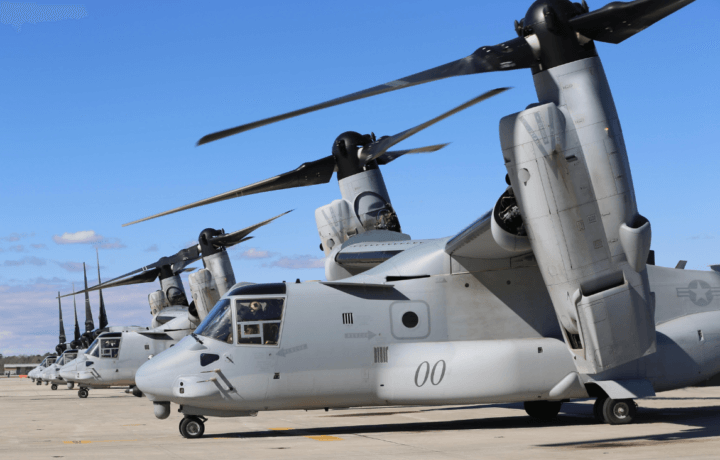Earlier this month, a congressional oversight committee launched an investigation into the V-22 Osprey program following a deadly crash in Japan in which eight United States Air Force special operations service members were killed. Following the November 29 crash, the entire Osprey fleet remains grounded except for limited United States Marine Corps flights in emergencies.
Lawmakers on the U.S. House of Representatives Committee on Oversight and Accountability sent a letter to Secretary of Defense Lloyd Austin requesting documents and information about the Osprey program’s safety and performance.
The committee noted that over the last 30 years, there have been more than a dozen Osprey crashes that have killed over 50 U.S. servicemembers. Chairman James Comer (R-KY) has sought to bring transparency and accountability to ensure the Department of Defense is taking the steps necessary to protect the lives of U.S. servicemembers.
“The Committee on Oversight and Accountability is investigating long-term problems regarding the reliability of the V-22 Osprey tiltrotor military aircraft (Osprey). Considering the recent Osprey crash off the shore of Yakushima, Japan, in addition to other crashes during the lifetime of this airframe, the Committee remains concerned about safety and performance issues surrounding the Osprey program,” wrote Chairman Comer in the letter to Secretary Austin.
“Further concern is warranted because the Department of Defense (DoD) grounded its entire fleet of Ospreys to mitigate risks,” added Comer. “It is crucial for the safety of our servicemembers to ensure transparency, accountability, and a thorough understanding of the steps DoD is taking to mitigate any further mechanical risks. The Committee is requesting documents and information to better understand the Osprey program’s performance, safety, and oversight.”
The government of Japan, the only international partner flying the Osprey, has also grounded its aircraft after the Nov. 29 crash.
Four Major Crashes in the Last Two Years
Of those American service members who have died in Osprey crashes, 20 were killed in four crashes over the last 20 months.
In August 2022, the United States Air Force grounded its entire fleet of CV-22 Osprey indefinitely. The decision was made following four incidents of “hard clutch engagement during flight” since 2017, with two of those occurring just in the previous six weeks. Lt. Gen. Jim Slife of the Air Force Special Operations Command was forced to issue the “safety stand down” due to the increased number of incidents.
The CV-22 Osprey, produced by Bell Helicopter Textron in Amarillo, TX, is a tiltrotor aircraft that combines the vertical takeoff, hover, and vertical landing qualities of a helicopter with the long-range, fuel efficiency, and speed characteristics of a turboprop aircraft. The mission of the CV-22 is to conduct long-range infiltration, exfiltration, and resupply missions for special operations forces.
There are currently 52 CV-22s in service with the Air Force.
A Military Aviation “Workhorse”
The CV-22 Osprey entered service in 2007, but only after decades of testing. While there have been high-profile crashes, the aircraft has still been described as a workhorse for the United States Marine Corps and Air Force Special Operations Command.
However, following more than nine years of attempts to redesign the U.S. Navy’s version of the aircraft to prevent engine failure, crash casualties continue. The oversight committee notes that numerous government watchdogs revealed problems in the Osprey program.
“The Committee recognizes the significant advantages the Osprey can bring to combat,” Comer further added in his letter to Austin. “The Osprey’s turboshafts can rotate ninety degrees, switching from a helicopter-like flight mode to a horizontal airplane-like configuration, and can carry twenty-four combat troops twice as fast and five times farther than previous helicopters. We also recognize the economic impact of the Osprey program, consisting of more than 500 U.S.-based suppliers, employing over 27,000 people across 44 states.”
The lawmaker went on to warn that if the same tiltrotor technology is planned for use in civilian aircraft or future military aircraft, additional oversight is needed to ensure public safety.
“Given the gravity of the loss of servicemembers’ lives, increasing costs, and the future economic impact and innovative applications of Osprey program technology, the Committee requests documents and information to shed light on aspects of the program’s safety and performance,” Comer continued.
Hard Clutch Issues
As previously reported, since 2010, the V-22 program has experienced a total of 15 instances of hard clutch engagement, including 10 with the United States Marine Corps Ospreys. This typically occurs when the clutch, which connects the propeller’s rotor gearbox to its engine, slips and subsequently causes the Osprey to transfer the power load to the other engine almost instantaneously so the aircraft can keep from crashing. The original gear box’s clutch then reengages, the power load transfers back in a span of milliseconds and the large transfer of torque causes the Osprey to lurch.
A defense official said that more than two-thirds of these clutch-related problems have occurred seconds after takeoff when power is quickly applied.
It is unclear at press time if the crash on Nov. 29 was related to a hard clutch issue.
Yet, the Marine Corps has distributed guidance on the hard clutch engagement issue, while the service would conduct briefings with Osprey aircrew and maintainers. The Marine Corps is now planning to work with the V-22 program office and industry partners to develop additional alert indicators in the cockpit over the long term, which could alert pilots when a clutch problem is emerging.



